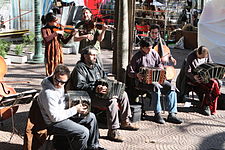- Milonga
-
Milonga Music Group playing at Buenos Aires

Milonga can refer to an Argentine, Uruguayan, and Southern Brazilian form of music which preceded the tango and the dance form which accompanies it, or to the term for places or events where the tango or Milonga are danced (see Milonga (place)). The term milonga comes from a similar expression that means "lyrics".[1]
Contents
Music
The Milonga originated in the Río de la Plata area of Argentina and Uruguay. It was very popular in the 1870s. The Milonga was derived from an earlier style of singing known as the payada de contrapunto. The song was set to a lively 2/4 tempo, as are most milongas.
"Milonga is an excited habanera." The original habanera divided into four pulses, in a standard two-four where every note was stressed. In becoming milonga, though, all four notes turned strong, as tempo was doubled. The strength of the first beat weakened the fourth giving an almost waltz-like feel to milonga: one-two-three(four), one-two-three(four). Habanera is a slower, more explicit sounding one, two, three-four. At least one modern tango pianist believes the polka influenced the speeding up of the milonga.[2]
Milonga has a syncopated beat, consisting of 8 beats with accents on the 1st, (sometimes also 2nd) 4th, 5th, and 7th beats.
- Regular 2/4
[1] 2 3 4 [5] 6 7 8
- Milonga
[1] 2 3 [4] [5] 6 [7] 8, sometimes also [1] [2] 3 [4] [5] 6 [7] 8
- 332
[1] 2 3 [4] 5 6 [7] 8
Over time, dance steps and other musical influences were added, eventually giving rise to the tango.
By the 1890s musicians were writing in a structured form that was something more than thinly disguised milongas or tangos andaluces, and would later become the fully developed tango.[3]
Dance
In a book published in 1883 Ventura Lynch, a noted contemporary student of the dances and folklore of Buenos Aires Province, noted the influence the Afro-Argentine dancers had on the compadritos, who apparently frequented the Afro-Argentine dance venues, "the milonga is danced only by the compadritos of the city, who have created it as a mockery of the dances the blacks hold in their own places".[4]
Ventura also noted the popularity of the milonga. "The milonga is so universal in the environs of the city that it is an obligatory piece at all the lower-class dances (bailecitos de medio pelo), and it is now heard on guitars, on paper-combs, and from the itinerant musicians with their flutes, harps and violins. It has also been taken up by the organ-grinders, who have arranged it so as to sound like the habanera dance. It is danced too in the low life clubs around...[main] markets, and also at the dances and wakes of cart-drivers, the soldiery and compadres and compadritos.[4]
Distinctive elements added from candombe were "quebradas," improvised, jerky, semi-athletic contortions, the more dramatic the better, and cortes, a suggestive pause, or sudden break in the figures of the dance. Unlike in the then "Tango" of that group, however, where these movements were danced apart, they were now danced together.[5] Jose Gobello suggested that the mazurka was also altered in the districts close to the docks. This Africanized milonga-tango, as well as the habanera and mazurka, was frowned upon, and found wholly unacceptable by some sections of Argentine high society.[4]
Milonga uses the same basic elements as Tango and requires a greater relaxation of legs and body. Movement is normally faster, and pauses are not made. It is rather a kind of rhythmic walking without complicated figures, with a much more "rustic" style than Tango.
There are different styles of Milonga: "Milonga Lisa" (Simple Milonga), in which the dancer steps on every beat of the music; and "Milonga con Traspié," in which the dancer uses Traspiés or contrapasos (changes of weight from one foot to the other and back again in double time or three steps in two beats) to interpret the music. Thus, dynamics may be danced without having to run fast or without the use of much space.
Artists
Uruguayan and Argentine artists known for their milonga compositions and interpretations include Roberto Firpo, Angel D'Agostino, Pedro Laurenz, Villoldo, Francisco Canaro, Rodolfo Biagi, Juan D'Arienzo, Edgardo Donato, Gabino Ezeiza, Anibal Troilo, Lucio Demare, Domingo Federico, Angel Vargas, Mariano Mores, Francisco Lomuto and Carlos Di Sarli. These artists are from the early years and the Golden era of tango.
Kevin Johansen is a modern Argentine rock artist who has a number of songs that combine folkloric and pop music with a milonga rhythm.
See also
References
- ^ Grove, Sir George; Stanley Sadie (1980). The New Grove dictionary of music and musicians. 19. Macmillan. p. 473. ISBN 0333231112.
- ^ Robert Thompson. "Tango the Art History of Love" page 129
- ^ Tango! The Dance, the Song, the Story. Collier, Cooper, Azzi and Martin. 1995. Thames and Hudson, Ltd, p. 51. ISBN 0-500-01671-2.
- ^ a b c Collier, 1995, pp. 44–45.
Citing Ventura Lynch, La provinciade Buenos Aires hasta la definicion de la cuestion Capital de la Republica, page 16. - ^ Collier, 1995, pp. 46–47.
Categories:- Song forms
- Latin music
- Argentine styles of music
- Dance in Argentina
- Tango
Wikimedia Foundation. 2010.

